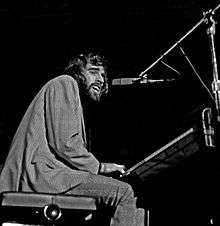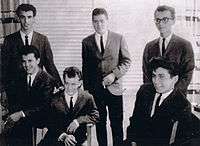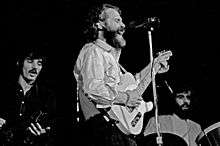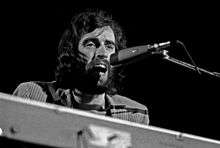Richard Manuel
| Richard Manuel | |
|---|---|
 Manuel in 1971 | |
| Background information | |
| Birth name | Richard George Manuel |
| Born |
April 3, 1943 Stratford, Ontario, Canada |
| Died |
March 4, 1986 (aged 42) Winter Park, Florida, United States |
| Genres | |
| Occupation(s) |
|
| Instruments |
|
| Years active | 1957–1986 |
| Labels | Capitol |
| Associated acts | |
Richard George Manuel (April 3, 1943 – March 4, 1986) was a Canadian composer, singer, and multi-instrumentalist, best known as the pianist, regular lead singer, and occasional drummer of The Band. He was a member of the original band from 1967 to 1976 and the re-formed band from 1983 until his death.
Biography
Early life and career
Manuel was born in Stratford, Ontario, Canada. His father, Ed, was a mechanic employed at a Chrysler dealership, and his mother was a schoolteacher. He was raised with his three brothers, and the four sang in the church choir. Manuel took piano lessons beginning when he was nine, and enjoyed playing piano and rehearsing with friends at his home. Manuel received a diploma from the Ontario Conservatory of Music in lap steel guitar; this was his only formal music certification. Some of his childhood influences were Ray Charles, Bobby Bland, Jimmy Reed and Otis Rush.

He and three friends started a band when he was fifteen, originally named the Rebels but later changed to the Revols, in deference to Duane Eddy and the Rebels. The group also included Ken Kalmusky, a founding member of Great Speckled Bird, and John Till, a founding member of the Full Tilt Boogie Band. Although primarily known as a naturally talented vocalist with a soulful rhythm and blues style and rich timbre (often compared to that of Ray Charles), Manuel also developed an intensely rhythmic style of piano unique in its usage of inverted chord structures. These talents were showcased in the Revols.
Manuel first became acquainted with Ronnie Hawkins and the Hawks when the Revols opened for them in Port Dover, Ontario. According to Levon Helm, Hawkins remarked to him about Manuel: "See that kid playing piano? He's got more talent than Van Cliburn." The two bands once again connected at the Stratford Coliseum in 1961, when the Revols ended a show featuring the Hawks as headliners. After hearing Manuel singing "Georgia on My Mind", Hawkins hired the Revols' pianist rather than competing with them.[1]
The Hawks
Manuel was eighteen when he joined Ronnie Hawkins's backing group, the Hawks. At this time the band already consisted of 21-year-old Levon Helm on drums, 17-year-old Robbie Robertson on guitar and 18-year-old Rick Danko on bass; 24-year-old organist Garth Hudson joined that Christmas, followed by two temporary members (saxophonist Jerry Penfound and singer Bruce Bruno). Increasingly antagonized by Hawkins's disdain for marijuana and circumspection toward contemporary music trends, the group left the venerable rockabilly singer's employ in 1964. Initially, they were known as the Levon Helm Sextet (as Helm had accumulated the most time with Hawkins) before changing their name to the Canadian Squires and then to Levon and the Hawks. With Helm serving as nominal leader because of his longevity with the Hawkins group, it was Manuel who sang most of the songs in the group's repertoire. Manuel was easily the most accomplished vocalist from a technical standpoint. It was as Levon and the Hawks, after the departure of Penfound and Bruno, that they introduced themselves to their blues hero, Sonny Boy Williamson. They planned a collaboration with Williamson, but he died before their plans could be realized.
In 1965, Helm, Hudson and Robertson helped back American bluesman John Hammond on his album So Many Roads. Hammond recommended the Hawks to Bob Dylan, who tapped them to serve as his backing band when he switched to an electric sound; through 1966, they toured Europe and the U.S. with Dylan, enduring the ire of Dylan's folk fans, who subjected the group to hissing and booing (although Helm left the tour for that reason). While they continued to believe in their ultimate goal to play and record their own music (a single, the folk rock–influenced "The Stones I Throw," was released by Atco Records in the fall of 1965), Dylan opened doors for them in the music business by introducing them to his manager, Albert Grossman, and taught them by example about writing their own material.
The Band
Big Pink
In 1967, while Dylan recovered from a motorcycle accident in Woodstock, New York, the group moved there also, renting a pink house on 100 acres (0.40 km2) and were paid a retainer by Dylan. Not having to be constantly working and traveling allowed them to experiment with a new sound garnered from the country, soul, rhythm and blues, gospel and rockabilly music that they loved. During this time, while Helm was temporarily absent from the group, Manuel taught himself to play drums in a technically irreverent, "loosey-goosey" style, a little behind the beat, similar to jazz drumming. In the Band era he would frequently assume the drummer's stool when Helm played mandolin or guitar. Examples of this are the songs "Rag Mama Rag" and "Evangeline". Manuel's drumming is prominent on the album Cahoots.

The early months in Woodstock also allowed Manuel and Robertson to develop as songwriters. After recording numerous demos and signing with Grossman, they secured a 10-album contract with Capitol Records in early 1968. They originally signed as "The Crackers" (although "The Honkies" had also been considered). Helm rejoined the fold as sessions got under way for the recording of their debut album, Music from Big Pink. The group proceeded to take what they had learned with Dylan and used one of his songs in the process. They combined it with their idea of the perfect album, switching solos, and singing harmony modeled after the gospel sound of their musical heroes the Staple Singers. Manuel contributed four songs, including the oft-covered "Tears of Rage", which he co-wrote with Dylan. A cover of "Long Black Veil" and a Danko–Dylan collaboration, "This Wheel's on Fire", rounded out the album. Music from Big Pink was released with the group name given as simply "The Band". This would be their name for the rest of the group's existence. While only reaching No. 30 on the Billboard charts, the album would have a profound influence on the nascent country rock movement; "Tears of Rage" and "The Weight" would rank among the most covered songs of the era. Shortly after the release of the album, the newly financially secure Manuel married his girlfriend, Jane Kristiansen, a model from Toronto, whom he had dated intermittently since the Hawks days. They would become the parents of two children.
Movie role, alcoholism, move to Malibu
In 1970, Manuel acted in the Warner Bros. film Eliza's Horoscope, an independent Canadian drama written and directed by Gordon Sheppard. He portrayed "the bearded composer," performing alongside Tommy Lee Jones, former Playboy Bunny Elizabeth Moorman, and Lila Kedrova.
During this period, Manuel's "Blues for Breakfast" (an early Woodstock composition) was covered by Cass Elliot on Dream a Little Dream (1968); shortly thereafter, Joan Baez performed an a cappella arrangement of "Tears of Rage" on Any Day Now (1968) and Karen Dalton included her rendition of "In a Station" on In My Own Time (1971). However, he was credited to writing only three songs ("When You Awake," "Whispering Pines," and "Jawbone") on The Band (1969) and two ("Sleeping" and "Just Another Whistle Stop") on Stage Fright (1970); all of these compositions were credited as collaborations with Robertson, who had assumed dominance in the group's affairs with Grossman. According to Helm,
When The Band came out we were surprised by some of the songwriting credits. In those days we didn’t realize that song publishing–more than touring or selling records–was the secret source of the real money in the music business. We’re talking long term. We didn’t know enough to ask or demand song credits or anything like that. Back then we’d get a copy of the album when it came out and that’s when we’d learn who’d got the credit for which song. True story.... When the album [The Band] came out, I discovered I was credited with writing half of “Jemima Surrender” and that was it. Richard was a co-writer on three songs. Rick and Garth went uncredited. Robbie Robertson was credited on all 12 songs. Someone had pencil-whipped us. It was an old tactic: divide and conquer. I went on to express [to Robertson] my belief in creating music with input from everyone and reminded him that all the hot ideas from basic song concepts to the mixing and sequencing of our record, were not always exclusively his. I complained that he and Albert had been making important business decisions without consulting the rest of us. And that far too much cash was coming down in his and Albert’s corner. Our publishing split was far from fair, I told him, and had to be fixed. I told him that he and Albert ought to try and write some music without us because they couldn't possibly find the songs unless we were all searching together. I cautioned that most so-called business moves had fucked up a lot of great bands and killed off whatever music was left in them. I told Robbie that The Band was supposed to be partners. Since we were teenagers, we banded against everything and anyone that got in our way. Nothing else–pride, friends, even money–mattered to the rest of us as much as the band did. Even our families had taken second place when the need arose. I said “Robbie, a band has to stick together, protect each other support and encourage each other and grow the music the way a farmer grows his crops.” Robbie basically told me not to worry because the rumors were true: Albert was going to build a state-of-the-art recording studio in Bearsville and wanted us to be partners in it with him. So any imbalance in song royalties would work out a hundred fold within the grand scheme of things. We would always be a band of brothers with our own place. No more nights in some company’s sterile studio...All we needed to do was play our music and follow our hearts. Well, it never quite worked out that way. We stayed in the divide and conquer mode, a process that no one ever seems to be able to stop to this day.[2]
By Cahoots (1971), producer John Simon felt that "Robbie didn't... consciously intimidate him... but when you met Robbie he was so smooth and urbane and witty, whereas Richard was such a gee-golly-gosh kind of guy"; the influence of Manuel's increasingly harmful abuse of heroin may have also contributed to the diminution of his songwriting abilities.[3]
By 1972, Manuel's burgeoning alcoholism began to impede the Band's recording and performance schedule. Years later, Robbie Robertson opined that "he scared us to death... we didn't know what the next day might bring, what would come out of this monster that had seeped out of the woodwork."[4] Although Jane Manuel lamented that "people thought it was amusing to watch this guy drowning," the Manuels briefly separated during this period but reconciled before the impending birth of their second child, Josh.[5] According to roommate Mason Hoffenberg (who cohabited with the musician in 1972–1973 at the behest of Grossman), Manuel had "stopped [using heroin] and got into this drinking thing... I'm supposed to head off all the juvenile dope dealers up here who hang around rock stars. So I answer the phone and say Richard's not here. He's not allowed to answer the phone. And I go around privately and tell them to leave him alone because he's really going to kill himself. But if they actually come over to the house, he can't say no. He's brilliant, that guy. An incredible composer. But we just sit around watching The Dating Game, slurping down the juice, laughing our asses off, then having insomnia, waking up at dawn with every weird terror and anxiety you can imagine. The four other guys in The Band are serious about working and he's really hanging them up. They can't work without him and there's no way to get him off his ass. He feels bad about it, he's just strung out."[6]
In 1973, the group once again followed the lead of Dylan by relocating to Malibu, California. Before leaving the Hudson Valley, they convened at Bearsville Studios to record an album of vintage rock and roll cover songs (many of which were seldom performed by the Hawks), entitled Moondog Matinee, in homage to Alan Freed's radio show. Although Manuel was initially reluctant to perform, the album elicited some of his finest vocal performances, including renditions of the Bobby "Blue" Bland R&B standard "Share Your Love with Me," the Platters' "The Great Pretender," and a tongue-in-cheek version of Jerry Leiber and Mike Stoller's obscure "Saved." Helm had this to say about Manuel during this period: "...he was drinking pretty hard, but once he got started, man: drums, piano, play it all, sing, do a lead in one of them high, hard-assed keys to sing in. Richard just knew how a song was supposed to go. Structure, melody; he understood it."[7]
Back with Dylan

The Band played to receptive audiences in the summer of 1973 at the Summer Jam at Watkins Glen and on a double bill with the Grateful Dead at Jersey City's Roosevelt Stadium. That fall the group backed up Dylan on his first proper release in three years, Planet Waves and were tapped to serve as his backup group once more on his first tour in eight years.
The concerts of the Bob Dylan and the Band 1974 tour, from January 3 to February 14, 1974, were meandering musical marathons featuring two sets of Dylan backed by the Band, two Band sets, and a Dylan acoustic set. The ensuing live album from the tour, Before the Flood, reveals that Manuel was still capable of reaching the breathtaking falsetto on "I Shall Be Released".
The Last Waltz
The Band continued touring throughout 1974, supporting Crosby, Stills, Nash and Young alongside Joni Mitchell and The Beach Boys on a grueling summer stadium tour. By 1975, Robertson had expressed his dissatisfaction with touring and was acting in an increasingly parental capacity, as the move to Malibu had seen him take the managerial reins on a de facto basis from an increasingly diffident Grossman. According to Helm, Manuel was now consuming eight bottles of Grand Marnier every day on top of a prodigious cocaine addiction, factors that ultimately precipitated his divorce from Jane Manuel in 1976. During that period, he developed a kinship with the similarly despondent Eric Clapton and was a driving force behind the boozy sessions that make up the guitarist's No Reason to Cry (1976). Recorded at the Band's new Shangri-La Studios, Manuel gave Clapton the song "Beautiful Thing" (a Band demo that Danko helped him finish) and provided vocals for "Last Night".

On the group's final full-fledged tour, Manuel was still recovering from a car accident earlier in the year; several tour dates were canceled after a power-boating accident near Austin, Texas, that summer, which necessitated the hiring of Tibetan healers, in a scenario reminiscent of Robertson's pre-show hypnosis before their first concert as the Band at the Winterland Ballroom in April 1968. The quality of the shows was frequently contingent upon Manuel's relative sobriety. As he could no longer sustain the high vocal register of "Tears of Rage" or "In a Station", his most notable contributions were confined to impassioned, raging versions of the prophetic "The Shape I'm In", "Rockin' Chair" and "King Harvest (Has Surely Come)", propelled by his hoarse (though still expressive) voice.
The Band played its final show as its original configuration at Winterland Ballroom in San Francisco on Thanksgiving Day of 1976. The concert was filmed in 35 mm by Robertson cohort and longtime Band fan Martin Scorsese for the documentary The Last Waltz. Manuel can be heard, but barely seen, singing "I Shall Be Released," surrounded by guest stars. While Manuel's famed sense of humor and warm, congenial nature emerged in the interview segments, so did his shyness and deferential attitude – and inebriation. Initially the group only intended to end live performances as the Band, and each member was initially kept on a retainer of $2,500 per week by Warner Brothers. However, by 1978, the group had drifted apart.
Attempted comeback
Taking advantage of this new solace, Manuel moved to Garth Hudson's ranch outside Malibu. He entered an alcohol and drug rehabilitation program, became sober for the first time in years and eventually remarried. During this time he played little-publicized gigs in L.A.-area clubs as leader of the Pencils (with Terry Danko on lead guitar). By 1980, Rick Danko and Manuel had begun to tour regularly as an acoustic duo; along with Hudson, Manuel played on several instrumental cues composed by Robertson for the soundtrack of Raging Bull (1980).
The Band reformed in 1983 with the Cate Brothers and Jim Weider augmenting the four returning members of the group – Manuel, Helm, Hudson, and Danko. Freed from his addictions, Manuel was initially in his best shape since the "Big Pink" era. Having reclaimed some of his vocal range lost in the years of drug abuse, Manuel performed old hits such as "The Shape I'm In", "Chest Fever", and "I Shall Be Released" alongside favorites such as Cindy Walker and Eddy Arnold's "You Don't Know Me" and "She Knows". During this time, Manuel co-wrote the song "Breaking New Ground" with Gerry Goffin and Carole King.[8]
Death
In January 1986, Albert Grossman died of a heart attack. He had been a father figure and confidant to Manuel and an instrumental figure in any possible solo career. Depressed by Grossman's death, dwindling access to prestigious concert venues and the perception that the Band had stagnated and had become a traveling jukebox, Manuel started using alcohol and cocaine again. On March 4, after a gig at the Cheek to Cheek Lounge, in Winter Park, Florida (outside Orlando), Manuel committed suicide.[9] He had appeared to be in relatively good spirits but ominously thanked Hudson for "twenty-five years of incredible music". The Band returned to the Quality Inn, down the block from the Cheek to Cheek Lounge, and Manuel talked with Levon Helm about music and film in Helm's room. According to Helm, at around 2:30 Manuel said he needed to get something from his room. Upon returning to his motel room, it is believed that he finished one last bottle of Grand Marnier before hanging himself. Manuel's wife Arlie—also intoxicated at the time—discovered his body along with the depleted bottle and a small amount of cocaine the following morning. He was buried a week later in his hometown of Stratford, Ontario.
At the end of March, Rick Danko declared, "I can't believe in a million years that he meant for that to happen. There was just no sign (...) I have to think this was just a goddamned silly accident."[10] A blood toxicology report indicated that Manuel was drunk and had ingested cocaine the day he died.[11]
Posthumous recognition
Although Manuel died before the Band recorded their final three albums, two songs featuring him on lead vocals, recorded in the 1980s, were included on the first two of these albums: "Country Boy", on Jericho (1993), and "She Knows", on High on the Hog (1996).
In 1994, Manuel was posthumously inducted into the Rock and Roll Hall of Fame as a member of the Band.[12] In 2015, he was inducted into the New York Blues Hall of Fame.[13]
In 2002, the Japanese label Dreamsville Records released Whispering Pines: Live at the Getaway, which contains selections from a solo performance by Manuel, recorded in Saugerties, New York, in October 1985.
Former bandmate Robbie Robertson's song "Fallen Angel" (1987), former bandleader Ronnie Hawkins's song "Days Gone By" (1995) and the Band's song "Too Soon Gone" (1993) are all tributes to Manuel.[14]
Eric Clapton's 1986 album, August, features his tribute to Manuel, entitled "Holy Mother". The San Francisco–area group the Call, who had collaborated with former Band members Hudson and Robertson, dedicated the video for their 1986 single, "Everywhere I Go", to Manuel. Counting Crows recorded the song "If I Could Give All My Love (Richard Manuel Is Dead)", released on their 2002 album Hard Candy. The Drive-By Truckers' song "Danko/Manuel" was released on their album The Dirty South in 2004.
Head of Femur included "Song for Richard Manuel" on their 2005 release, Hysterical Stars. In 2008, the Michigan roots quartet Steppin' In It released the album Simple Tunes for Troubled Times, which contains the song "The Ghost of Richard Manuel", while Isaac Gillespie's album 1971 features "Richard Manuel the Pacifier". The Vancouver band Books & Branches' album Caribou Whispers features a song entitled "Richard Manuel". Ray Lamontagne referred to the singer during his performance on the BBC program Songwriter's Circle. In 2012 Black Prairie released A Tear in the Eye Is a Wound in the Heart, which includes the song "Richard Manuel".
An article about Manuel and Rick Danko by Allen St. John was published on Forbes.com on April 19, 2012.[15]
Discography
- Whispering Pines: Live at the Getaway (2002)
- Live at O'Tooles Tavern (2009; recorded live in Scranton, Pennsylvania, on December 12, 1985)
- Live at the Lone Star (2011; recorded live in New York City in 1984)
References
- ↑ Helm and Davis, This Wheel's on Fire, pp. 86–87.
- ↑ http://www.forbes.com/sites/allenstjohn/2012/04/19/the-real-world-business-lessons-of-levon-helms-hardscrabble-life/4/19/2012 @ 5:05PM
- ↑ Hoskyns, Across the Great Divide, pp. 181–182.
- ↑ Hoskyns, Across the Great Divide, p. 272.
- ↑ Hoskyns, Across the Great Divide, pp. 275, 308.
- ↑ "Sam Merril: Mason Hoffenberg Gets in a Few Licks". Theband.hiof.no. Retrieved 2014-07-04.
- ↑ Helm and Davis, This Wheel's on Fire, p. 236.
- ↑ "Carole King Discography". caroleking.com. Retrieved July 30, 2015.
- ↑ Pareles, Jon (March 6, 1986). "Richard Manuel, 40, Rock Singer and Pianist". New York Times. Retrieved June 3, 2009.
- ↑ "The Band Still Feels Shock of Richard Manuel Death". The Day, March 25, 1986.
- ↑ "Manuel Had Cocaine in Blood, Tests Show". Ottawa Citizen. March 12, 1986. Retrieved June 10, 2013.
- ↑ List of Rock and Roll Hall of Fame inductees
- ↑ http://www.blueshalloffame.com/20th_Century_Blues_Artists/20th_Century_Blues_Artists.html
- ↑ "Remembering Richard Manuel". Theband.hiof.no. Retrieved 2013-04-02.
- ↑ "A Tribute to Levon Helm's Departed Band Mates, Rick Danko and Richard Manuel". Forbes. April 18, 2012. Retrieved 2013-04-02.
Bibliography
- Helm, Levon and Davis, Stephen (1993). This Wheel's on Fire, A Cappella Books, ISBN 1-55652-405-6
- Levin, Martin, (1996) The Lonesome Death of Richard Manuel: The Day the Music Died. Toronto Life.
External links
- Biography at Allmusic.com
- Manuel at The Band's website
- The Other Side: Richard Manuel by Peter Stone Brown
- Richard Manuel at Find a Grave